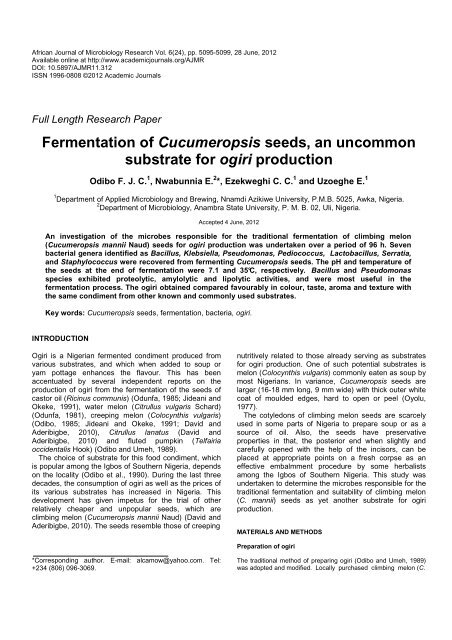Microbiology Research - Academic Journals
Microbiology Research - Academic Journals
Microbiology Research - Academic Journals
You also want an ePaper? Increase the reach of your titles
YUMPU automatically turns print PDFs into web optimized ePapers that Google loves.
African Journal of <strong>Microbiology</strong> <strong>Research</strong> Vol. 6(24), pp. 5095-5099, 28 June, 2012<br />
Available online at http://www.academicjournals.org/AJMR<br />
DOI: 10.5897/AJMR11.312<br />
ISSN 1996-0808 ©2012 <strong>Academic</strong> <strong>Journals</strong><br />
Full Length <strong>Research</strong> Paper<br />
Fermentation of Cucumeropsis seeds, an uncommon<br />
substrate for ogiri production<br />
Odibo F. J. C. 1 , Nwabunnia E. 2 *, Ezekweghi C. C. 1 and Uzoeghe E. 1<br />
1 Department of Applied <strong>Microbiology</strong> and Brewing, Nnamdi Azikiwe University, P.M.B. 5025, Awka, Nigeria.<br />
2 Department of <strong>Microbiology</strong>, Anambra State University, P. M. B. 02, Uli, Nigeria.<br />
Accepted 4 June, 2012<br />
An investigation of the microbes responsible for the traditional fermentation of climbing melon<br />
(Cucumeropsis mannii Naud) seeds for ogiri production was undertaken over a period of 96 h. Seven<br />
bacterial genera identified as Bacillus, Klebsiella, Pseudomonas, Pediococcus, Lactobacillus, Serratia,<br />
and Staphylococcus were recovered from fermenting Cucumeropsis seeds. The pH and temperature of<br />
the seeds at the end of fermentation were 7.1 and 35°C, respectively. Bacillus and Pseudomonas<br />
species exhibited proteolytic, amylolytic and lipolytic activities, and were most useful in the<br />
fermentation process. The ogiri obtained compared favourably in colour, taste, aroma and texture with<br />
the same condiment from other known and commonly used substrates.<br />
Key words: Cucumeropsis seeds, fermentation, bacteria, ogiri.<br />
INTRODUCTION<br />
Ogiri is a Nigerian fermented condiment produced from<br />
various substrates, and which when added to soup or<br />
yam pottage enhances the flavour. This has been<br />
accentuated by several independent reports on the<br />
production of ogiri from the fermentation of the seeds of<br />
castor oil (Ricinus communis) (Odunfa, 1985; Jideani and<br />
Okeke, 1991), water melon (Citrullus vulgaris Schard)<br />
(Odunfa, 1981), creeping melon (Colocynthis vulgaris)<br />
(Odibo, 1985; Jideani and Okeke, 1991; David and<br />
Aderibigbe, 2010), Citrullus lanatus (David and<br />
Aderibigbe, 2010) and fluted pumpkin (Telfairia<br />
occidentalis Hook) (Odibo and Umeh, 1989).<br />
The choice of substrate for this food condiment, which<br />
is popular among the Igbos of Southern Nigeria, depends<br />
on the locality (Odibo et al., 1990). During the last three<br />
decades, the consumption of ogiri as well as the prices of<br />
its various substrates has increased in Nigeria. This<br />
development has given impetus for the trial of other<br />
relatively cheaper and unpopular seeds, which are<br />
climbing melon (Cucumeropsis mannii Naud) (David and<br />
Aderibigbe, 2010). The seeds resemble those of creeping<br />
*Corresponding author. E-mail: alcamow@yahoo.com. Tel:<br />
+234 (806) 096-3069.<br />
nutritively related to those already serving as substrates<br />
for ogiri production. One of such potential substrates is<br />
melon (Colocynthis vulgaris) commonly eaten as soup by<br />
most Nigerians. In variance, Cucumeropsis seeds are<br />
larger (16-18 mm long, 9 mm wide) with thick outer white<br />
coat of moulded edges, hard to open or peel (Oyolu,<br />
1977).<br />
The cotyledons of climbing melon seeds are scarcely<br />
used in some parts of Nigeria to prepare soup or as a<br />
source of oil. Also, the seeds have preservative<br />
properties in that, the posterior end when slightly and<br />
carefully opened with the help of the incisors, can be<br />
placed at appropriate points on a fresh corpse as an<br />
effective embalmment procedure by some herbalists<br />
among the Igbos of Southern Nigeria. This study was<br />
undertaken to determine the microbes responsible for the<br />
traditional fermentation and suitability of climbing melon<br />
(C. mannii) seeds as yet another substrate for ogiri<br />
production.<br />
MATERIALS AND METHODS<br />
Preparation of ogiri<br />
The traditional method of preparing ogiri (Odibo and Umeh, 1989)<br />
was adopted and modified. Locally purchased climbing melon (C.

















